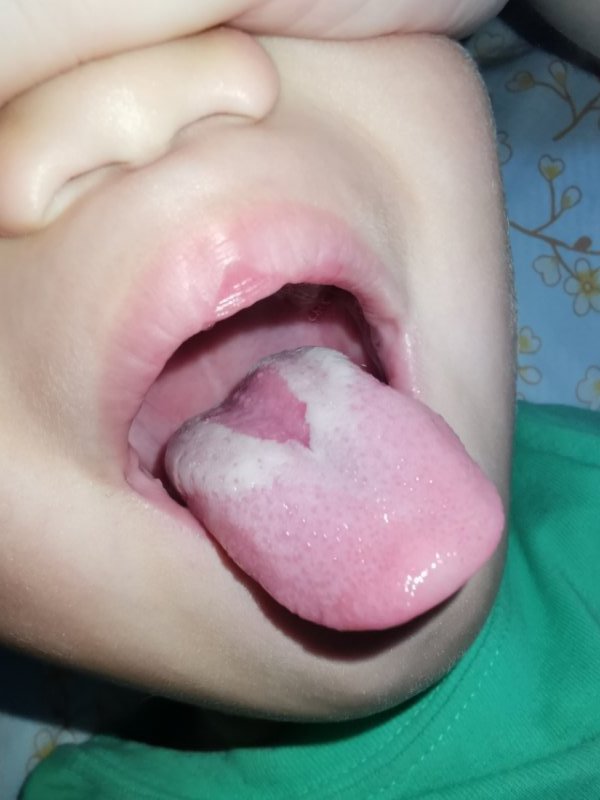Median rhomboid glossitis
OVERVIEW
What is Median Rhomboid Glossitis?
Median rhomboid glossitis, also known as central papillary atrophy, was previously considered a developmental lesion caused by the failure of the tuberculum impar to be covered by the lateral processes of the tongue during embryogenesis. It is characterized by a well-defined, pink to reddish-purple patch on the mid-posterior surface of the tongue. The patch ranges in size from 0.5 to 2 cm and may be round or rhomboid in shape. It is uncommon in children but found in about 1% of adults. The condition is typically benign and not associated with cancer. However, it appears to be linked to infections (e.g., Candida) and diabetes, often resolving after antifungal treatment. If no other abnormal symptoms are present, management involves observation, follow-up, and appropriate antifungal therapy, with no adverse impact on daily life.
SYMPTOMS
What are the manifestations of median rhomboid glossitis?
Median rhomboid glossitis presents as a clearly demarcated, diamond-shaped or oval erythematous and atrophic area on the midline of the dorsum of the tongue (just anterior to the circumvallate papillae), devoid of filiform papillae (i.e., lacking tongue coating) (as shown in Figure 1). The surface of the tongue appears smooth or lobulated, with a deep red color, forming a sharp contrast with the adjacent coated tongue.

Occasionally, raised pale yellow papules or irregular nodules may be observed, and palpation reveals a slightly firm lesion. Fissures on the tongue are often present, accompanied by mild inflammatory redness. The condition is usually asymptomatic, but when deep fissures are present with an inflammatory reaction, it may cause varying degrees of localized pain, irritation, or itching, depending on the individual.
Median rhomboid glossitis can persist indefinitely, rarely enlarges, and is almost always associated with chronic candidal infection. There is no direct link between this condition and cancer. If palatitis (inflammatory reaction of the palate) occurs in the area contacting the tongue lesion, it may be a sign of HIV infection or other immunodeficiency. Therefore, if the lesion is accompanied by other symptoms, testing for diabetes or immunodeficiency may be necessary, and a biopsy might also be required to rule out cancer.
CAUSES
What causes median rhomboid glossitis?
This condition is generally considered a developmental abnormality. Since the symptoms are not obvious, it often goes unnoticed, and most patients are diagnosed during dental examinations. Surveys report an incidence rate of 0.3% in the general population and about 1% in adults. Some medical experts suggest it may be a clinical manifestation of local fungal (Candida) infection.
DIAGNOSIS
How is median rhomboid glossitis diagnosed?
The disease can be diagnosed based on typical clinical manifestations; fungal microscopy and culture may assist in diagnosis.
Biopsy may reveal the absence of filiform papillae, epithelial hyperplasia, nonspecific inflammation, and Candida albicans hyphae embedded in the parakeratotic layer.
What diseases should median rhomboid glossitis be differentiated from?
Asymptomatic median rhomboid glossitis generally does not require specific differentiation.
If palatal inflammation (inflammatory reaction of the palate) occurs in the area contacting the tongue lesion, it may indicate HIV infection or other immunodeficiency. Therefore, when lesions are accompanied by other symptoms, testing for diabetes or immunodeficiency may be necessary, and a biopsy might also be required to rule out cancer.
TREATMENT
Which department should I visit for median rhomboid glossitis?
Generally, you can visit the dermatology department, or you may also go to the stomatology department.
How is median rhomboid glossitis treated?
-
If there are no symptoms, no special treatment is usually required, and observation and follow-up may suffice.
-
Surgical removal is generally unnecessary unless cancer is suspected, in which case a biopsy should be performed.
-
Oral antifungal medications such as itraconazole can improve the condition or lead to a cure.
DIET & LIFESTYLE
What should be noted in daily life for median rhomboid glossitis?
There are no special precautions in daily life, just maintain a healthy lifestyle.
-
Do not smoke;
-
Exercise regularly to boost immunity;
-
Avoid prolonged sitting, prevent overweight and obesity. Exercise 3–5 times a week for about 30 minutes each session, combining aerobic and strength training with moderate intensity and avoiding overexertion;
-
Ensure sufficient sleep daily, whether going to bed early or late;
-
Learn to manage stress and emotional tension.
What dietary precautions should be taken for median rhomboid glossitis?
There are no specific dietary restrictions; just maintain a healthy and balanced diet.
-
Use less salt, oil, and high-sodium seasonings when cooking. Limit intake of pickled vegetables and meats;
-
Avoid relying solely on refined grains. Replace some staple foods with whole grains, legumes, potatoes, or pumpkin;
-
Balance meat and vegetables. Prioritize white meats like chicken, duck, and fish, and limit fatty meats. Eggs and milk are important sources of protein and other nutrients;
-
For vegetarians, consume more beans and soy products to supplement protein;
-
Eat plenty of fruits and vegetables;
-
Avoid alcohol as much as possible.
PREVENTION
Can Median Rhomboid Glossitis Be Prevented?
Median rhomboid glossitis is a developmental abnormality that often cannot be prevented. However, since it is almost always associated with chronic fungal infections, the following methods may help reduce its occurrence:
-
Maintain daily oral hygiene by brushing teeth morning and night to clean teeth and the oral cavity;
-
Engage in regular exercise to boost immunity;
-
Adopt a healthy lifestyle to reduce the risk of diseases that weaken the immune system.